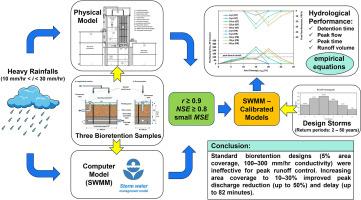Hydrological performance and design of bioretention systems for heavy rainfall management: A laboratory study
引用次数: 0
Abstract
Bioretention systems are widely used for urban stormwater management, yet their performance under intense rainfall—especially in tropical regions—remains underexplored. This study evaluated the hydrological performance of three full-scale bioretention cells (100 × 50 × 70 cm) with varying soil–sand compositions, tested using a custom rainfall simulator. Saturated hydraulic conductivities ranged from 63.3 to 325.6 mm/hr. The Storm Water Management Model (SWMM) was used to simulate the bioretention cells and was calibrated and validated against experimental data, showing strong agreement (r > 0.9; NSE > 0.8). Results indicated that standard designs (100–300 mm/hr conductivity; 5% area coverage) were insufficient for mitigating peak flows under heavy rainfall events (P > 100 mm; iave > 10 mm/hr). Increasing area coverage from 5% to 30% reduced peak discharge by up to 50%, delayed peak runoff by 82 min, and extended detention time. Runoff volume reductions ranged from 2.1–11.2% for 2-year design storms and 1.4–6.8% for 50-year events. An area coverage of 10–20% is recommended for effective mitigation. Dimensionless empirical equations were developed for design applications, and refinements to SWMM’s percolation modeling are suggested to improve model accuracy.

暴雨管理生物滞留系统的水文性能和设计:实验室研究
生物滞留系统被广泛用于城市雨水管理,但其在强降雨条件下的表现,特别是在热带地区,仍未得到充分研究。本研究评估了三个全尺寸生物滞留细胞(100 × 50 × 70 cm)在不同土砂组成下的水文性能,并使用定制的降雨模拟器进行了测试。饱和水力导率范围为63.3 ~ 325.6 mm/hr。暴雨水管理模型(SWMM)用于模拟生物滞留细胞,并根据实验数据进行校准和验证,显示出很强的一致性(r > 0.9; NSE > 0.8)。结果表明,标准设计(100 - 300毫米/小时电导率;5%面积覆盖率)不足以缓解强降雨事件(P >; 100毫米;iave >; 10毫米/小时)的峰值流量。将面积覆盖率从5%增加到30%,峰值流量减少了50%,峰值径流延迟了82分钟,并延长了滞留时间。2年设计风暴的径流量减少幅度为2.1-11.2%,50年设计风暴的径流量减少幅度为1.4-6.8%。为有效缓解,建议面积覆盖率为10-20%。建立了无量纲经验方程用于设计应用,并对SWMM渗流模型提出了改进建议,以提高模型精度。
本文章由计算机程序翻译,如有差异,请以英文原文为准。
求助全文
约1分钟内获得全文
求助全文

 求助内容:
求助内容: 应助结果提醒方式:
应助结果提醒方式:


